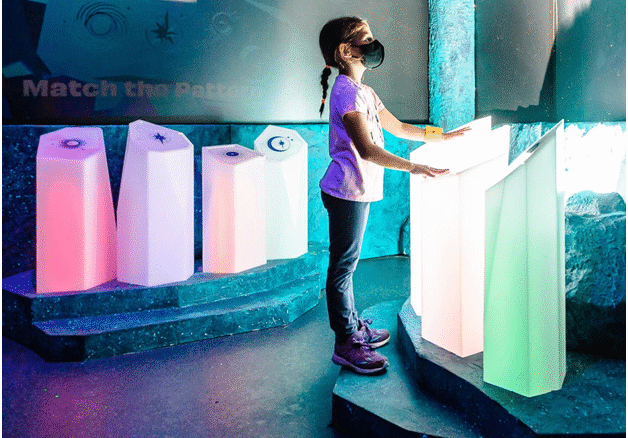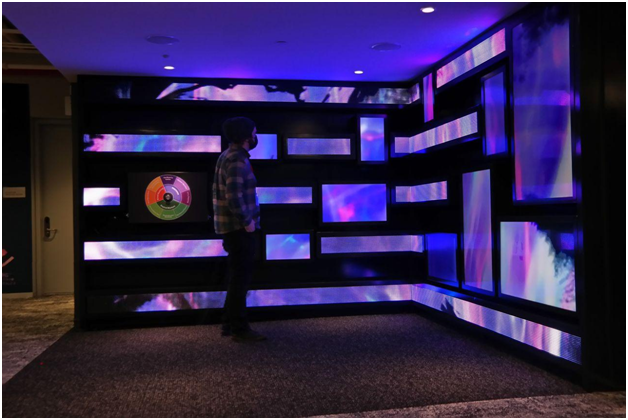
In an increasingly digitized world, Jill Shah’s professional profile sits at the fascinating intersection of physical space and digital imagination, defining the role of a creative technologist with a unique blend of architectural foresight and artistic sensibility. With over four years of experience in the Art and Themed Entertainment Industry, Shah is dedicated to crafting interactive and thought-provoking experiences that challenge perceptions and leave a lasting impact.
Shah, an architect by training, describes her current profession as a dynamic balance between traditional design and cutting-edge development. “I think a creative technologist can choose where to be on that scale of design to developer,” she explains. “I personally, am more on the side of design/architecture. But I borrow heavily from both worlds.” This hybrid approach allows her to envision possibilities that transcend conventional boundaries, much like an architect designs a building, but with the added dimension of digital interaction.
Her work is deeply rooted in the “what ifs.” Shah elaborates, “Like an architect, I think about space, structure, and materials. Like a developer, I build systems and sometimes even write code. But mostly, I live in the world of ‘what ifs.’ What if this wall could light up when you touch it? What if a room reacted to your mood? My role is to connect physical space with digital imagination.” This philosophy drives her to create experiences where technology isn’t just a tool, but a medium for sensory awakening.
Art has always been central to Shah’s methodology, infusing her projects with imagination, beauty, and emotional resonance. She is passionate about introducing “more humanised nuances in an increasingly mechanised world,” ensuring that her work allows users to “touch, feel and ponder over the role that technological advancements can play in pushing experiences and entertainment to newer boundaries.”
Shah holds an MFA in Design and Technology from Parsons School of Design. Following her graduation, she carved out a significant role as an Experiential Production Designer at Future Colossal, an acclaimed innovation lab known for designing and executing memorable interactive spaces. Beyond her professional endeavors, Shah is a committed educator, driven by the belief that skills and knowledge should be accessible. She has taught design classes and facilitated numerous technical workshops at The New School in NYC, empowering the next generation of creative technologists.
Jill Shah exemplifies how artistic vision, combined with technological prowess, can redefine our interaction with engineered spaces, fostering experiences that are not only innovative but deeply human. She speaks to Business News This Week about the magic of design, defining her job and how she creates experiences, above all else.
Can you break down in layman’s terms what your job entails?
Jill Shah: At the core, I design experiences. That might mean location based interactive experiences, museum exhibits, theme park games, or brand activations. My job is to figure out how people will/should feel and behave in a space, and then use technology like hardware sensors, screens, lights or audio to bring that feeling to life. It’s part storytelling, part architecture, and part engineering magic.
Where does a creative technologist fall on the scale of architect to developer?
I think a creative technologist can choose where to be on that scale of design to developer. I personally, am more on the side of design/architecture. But I heavily borrow from both worlds. Like an architect, I think about space, structure, and materials. Like a developer, I build systems and sometimes even write code. But mostly, I live in the world of “what ifs.” What if this wall could light up when you touch it? What if a room reacted to your mood? My role is to connect physical space with digital imagination.
As technology percolates more and more into architecture, where do you see the future of your profession?
The line between digital and physical design is going to blur completely. People are getting used to the world reacting to them—whether it’s smart home systems, video games or their screen devices. They are starting to expect that kind of responsiveness everywhere, even in buildings. So I think our profession will become less about fixed structures and more about adaptable, interactive environments that respond to people in real time.
When approaching your projects how do you take into account the financial restraints?
Every idea has to work within a budget. Oftentimes, the budget becomes the third creative on the table. It forces you to be clever. Research, prototyping and testing are three keys when it comes to working within the financial constraints. That process helps identify what is working, what isn’t and where the highest ROI is in a project. Not everything needs to be high-tech and not every space needs a lavish material pallet. It’s about creating the right moment at the right place and focusing on the message or the experience your project is trying to impart to its audience. I am also a firm believer in doing one thing, but doing it right; instead of trying to do ten different things in a single project.
What was your favorite project to work on to date?
One of my favorites has been Squid Game: TheTrials, an experience built in collaboration with Superfly and Future Colossal. Netflix’s Squid Game was brought to life as a high-stakes, real world adventure where fans entered as anonymous, numbered participants then advanced through six tech-augmented, gamified challenges inspired by nostalgic childhood games.
As Spatial and Production Designer, I was involved from the pitch and concept phases through the launch of this experience, helping shape creative vision and spatial narrative. My role spanned scenic design, interactive tech integration, projection mapping and the installation of complex physical systems – all crafted to heighten tension, build cinematic immersion and deliver a story-driven fan experience.
How do designs like the Accenture Hives signal the future when it comes to experiential workplace environments?
They show that people want more than just desks and meeting rooms. They want to feel inspired. The Hives were about creating flexible, tech-enabled spaces that encourage creativity and collaboration. You can feel the difference when a space responds to the way people actually work instead of forcing people to fit into a rigid environment.

You have worked on projects for all age ranges, is there a specific group who you get the most enjoyment out of watching them interact with your design?
Kids, for sure. They don’t hold back. If something is boring or confusing, you’ll know right away. But when something clicks, their joy is totally unfiltered. It’s the best kind of feedback and a reminder that design should always feel like a little bit of magic.
Do you often get to visit your past projects to see how people interact with them?
I wouldn’t say that happens often; but I try. It’s a grounding experience to see something you worked on live. No amount of renderings, pre-visualization or playtests amount to seeing your audience experience your work real time. It is joyful and there are learnings for future work that one wouldn’t get otherwise
How did you decide that you wanted to make people’s lives more “magical”?
I think it started with architecture school, where everything was very serious and abstract. But I kept being drawn to playful, interactive ideas. I realized I wasn’t interested in designing buildings just to be admired, I wanted people to do something inside them, to feel something unexpected. That’s where the magic lives.
Is the future of design immersive and how do you see that benefitting society?
Absolutely. Immersive design helps people connect more deeply with a story, with a place, with each other. It makes information more memorable and spaces more human. Whether it’s education, public art, or even healthcare, I think we’ll see more environments that aren’t just functional but emotional.
Your education has spanned continents and approaches, from the physical to the digital and now bundling it all together, but what does the future hold for you? And how are you actively pursuing that future?
I want to grow into an Experiential Creative Director and take on leadership roles. I want to curate spaces that blend creative technology with architecture, storytelling, and game design. Right now, I’m experimenting with tools like AI, real-time sensors, and modular fabrication. The goal is to make joyful, meaningful experiences more accessible and more scalable. The future is playful, and I want to help shape it.

